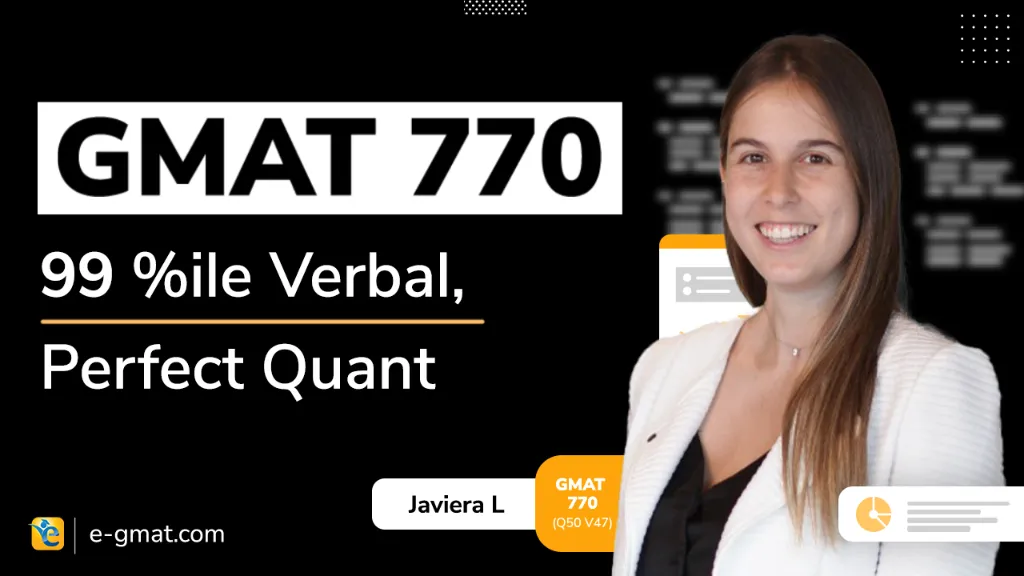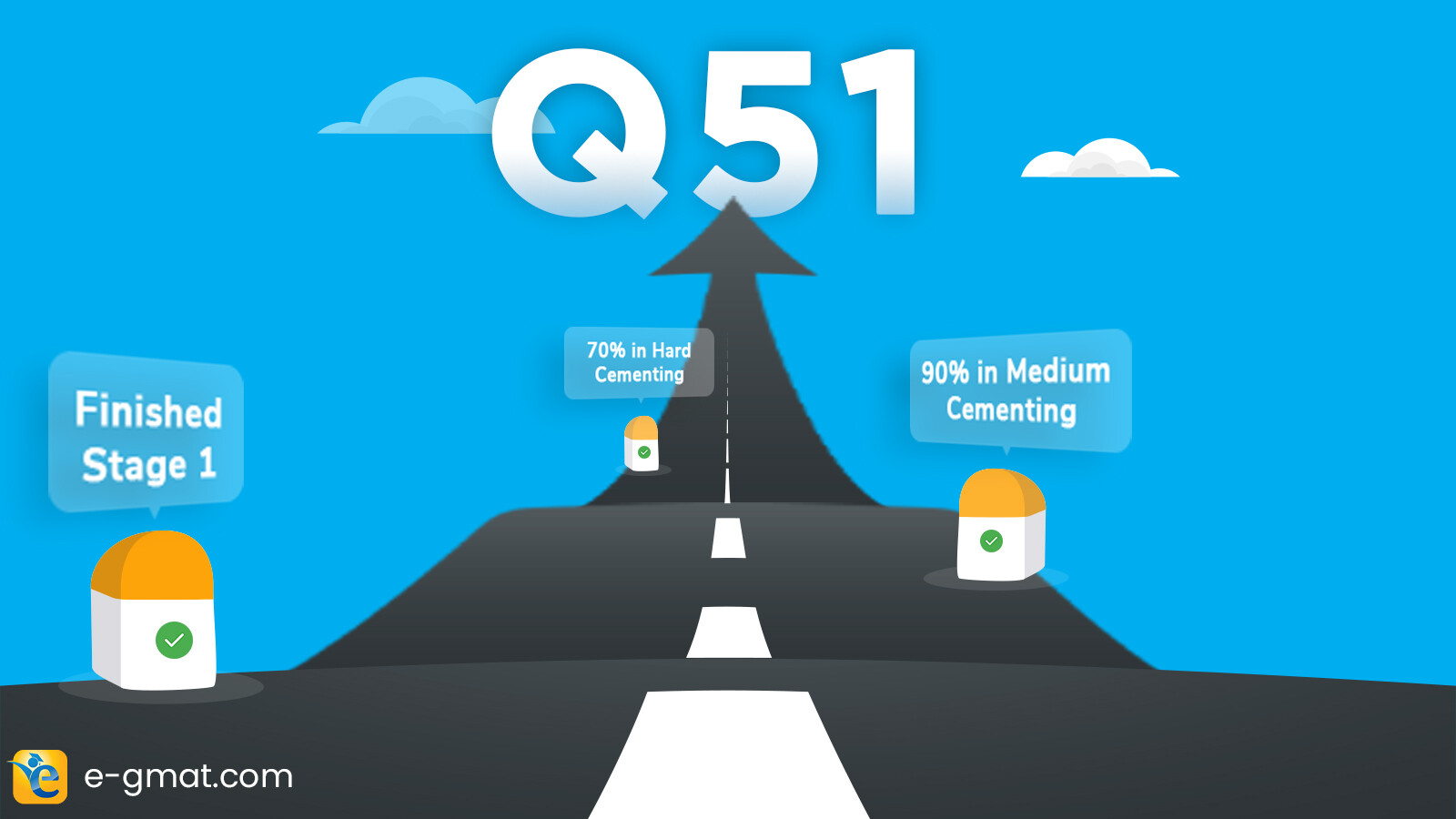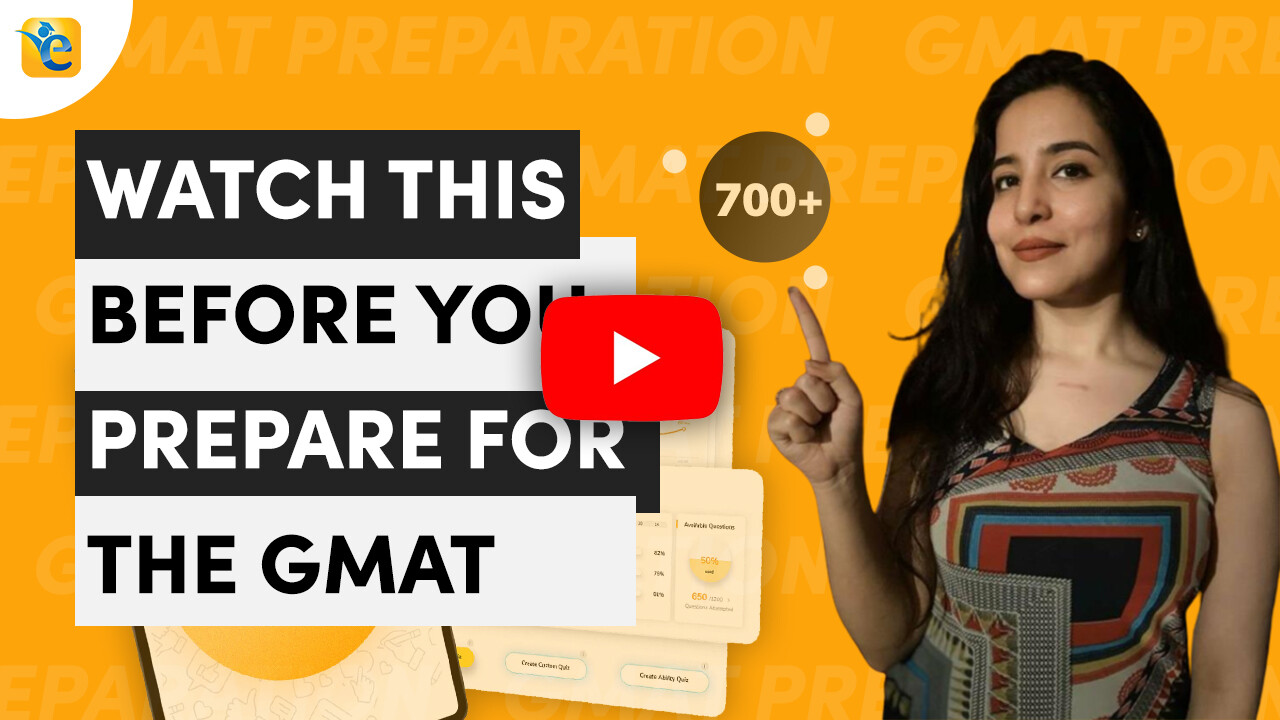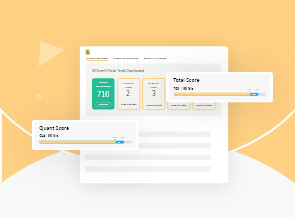For working professionals, GMAT preparation is a game of maximizing learning while balancing multiple other aspects of their lives. It demands planning, discipline, and prioritization – highly valued skills in an ideal B-School candidate and a professional.
GMAT 770 (Q50, V47) scorer Javiera, a BCG consultant, faced the same challenge when she decided to prepare for the GMAT while working 12 to 13-hour long days.
Exceptionally diligent and disciplined, Javiera followed everything suggested by e-GMAT down to the T. She found the e-GMAT platform intuitive, well-structured, and straightforward. She progressed by following the recommended course structure, which gave her complete confidence in her improving abilities in quant and verbal. She never even felt the need to seek any support from e-GMAT experts.
Watch Javiera, as she talks about her strategies to make a 130-point improvement in two attempts and bag a fantastic 99th percentile in GMAT.
Payal: Congratulations on your 770(Q50, V47). That’s a fantastic score. It was your second attempt; on the first attempt, you took about two and a half months and scored a 710; in one and a half months, you took your second try. How does it feel?
Javiera: It feels relieving. I couldn’t stop smiling when I saw my results.
Payal: It was all predictable as you scored high also in your SIGma-X mocks, right?
Javiera: yes, the day before, on my mock, I scored the same 770 with the same split.
Payal: Give us some details about your background.
Javiera: I have lived all my life in San Diego. I did chemical engineering in 2019, and since then, I have been into consulting.
I used only e-GMAT to prepare. I’d study for 2 hours in the morning every day before starting my project work. I’d do verbal first and then quant. And once I finished going through the course. Afterward, on the weekends, when I had more time, I’d practice with mocks and review.
Benefit of structured GMAT prep
Payal: In Feb, as you started with your GMAT prep with e-GMAT, you took your first SIGma-X mock and scored a 640. Your verbal was already much stronger than quant; you were already at V39.
Tell me why did you choose the e-GMAT course to prepare for GMAT?
Javiera: Many of my colleagues who’d studied using the course recommended e-GMAT. I needed a one-stop shop which has everything so I could understand what to do; a well-planned and straightforward method could tell me what I had to do and learn without having to take the trouble of planning.
I got a personalized study plan that clearly detailed my strong and weak areas. It was a great peace of mind that the program was showing me the path forward.
I have a very hectic work schedule; it was a great relief to have a clear direction in the course.
I got a personalized study plan that clearly detailed my strong and weak areas. It was a great peace of mind that the program was showing me the path forward.
How to use pre-thinking in CR?
Payal: You found out about learning methods with the course. Tell me about the process or method you used before you started with e-GMAT to solve CR questions and how it changed later.
Javiera: So, earlier, I didn’t have a process. I would just read the question, read all the answer choices, and go for the one that made more sense to me. I wasn’t doing it because I had a standardized process. While selecting my answers, I would not be sure 100% as I did not follow any steps to get there. But, with e-GMAT, I had the steps to follow; pre-thinking for CR, the falsification condition, and the process of eliminating answer choices.
So, I always stuck to pre-thinking in Critical Reasoning. I’d read the statement first, then do my pre-thinking and come up with some cases that would strengthen or weaken my answer depending on the question and go to the alternatives before selecting the option that was in line with my pre-thinking. And if I missed out, I’d go through the given answer choices and pre-think backward with the relevant keywords in mind.
That helped me feel more secure during the test, which is fundamental. Keeping your nerves calm and ensuring that you’re making progress during the exam is essential.
I always stuck to pre-thinking in Critical Reasoning. I’d read the statement first, then do my pre-thinking and come up with some cases that would strengthen or weaken my answer depending on the question and go to the alternatives before selecting the option that was in line with my pre-thinking. And if I missed out, I’d go through the given answer choices and pre-think backward with the relevant keywords in mind.
Payal: So, you had a very robust thought process to approach each type of question.
I want to ask what many students also ask; how can I pre-think the exact answer? As you rightly said, you don’t necessarily have to pre-think the correct answer. What did pre-thinking do? Did it help you understand the passage more, so you were confident while evaluating the answer choices?
Javiera: Yes. At times, I did my pre-thinking, which wasn’t in the alternatives; it is possible because many things could strengthen or weaken the statement. But with the pre-thinking, you start with understanding the passage and thinking of the clause passage is based on.
And even if the alternatives are not the same as you thought, the process definitely helps. Because as you read the answer choices, you’d already given it a thought, you don’t select the better-sounding one anymore.
Even if I found the correct choice, I’d always make sure to eliminate all the incorrect answer choices.
Payal: That’s crucial because it becomes a faltering point for many students. They would see the first option that seems to match their thinking and select the answer, only to realize that what they chose was a trap answer choice.
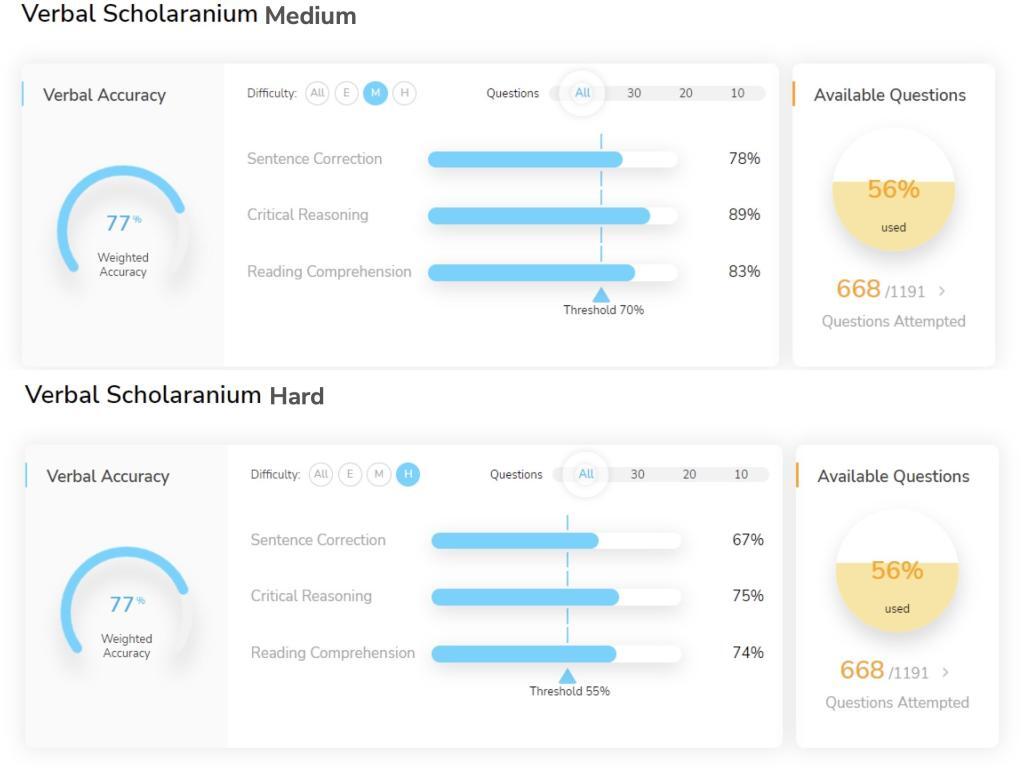
Javiera’s quant prep
Walk me through your quant prep. you started off thinking it was your weaker section, then what happened?
Javiera: Yeah, I started thinking I’m going to do well in verbal but just about decent in quant. I hadn’t done math problems in a long time. I finished school in 2013, and when I was in engineering, we saw a lot of math, but those were more detailed such as calculus etc unlike multiple choice questions in the GMAT.
I felt I had forgotten quant fundamentals, and even if I hadn’t, I thought I would not be able to solve the questions in one and a half minutes. I thought it would be challenging, but it came to me quickly after going through the course.
I loved the mathematical explanations behind various rules I’d learned in school but did not know their rationale. I’ll never forget them now.
Payal: You’re saying that the course gave you the proper conceptual understanding and wasn’t just about memorizing.
Javiera: yes, I think that was useful because in some of the questions you can use the same properties differently. So, if you understand them, it’s easier. Number property was the topic I was most insecure about as I didn’t know the concepts. I did the maximum number of quizzes in NP.
Payal: Number properties is a giant. Algebra and NP courses set the foundation of everything else in quant.
You used PACE architecture. How was your experience with it?
Watch this video to learn about P.A.C.E The next generation of Personalized Learning for GMAT Aspirants
Javiera: I loved it. I mentioned in the beginning how helpful it is to get clear instructions on how to go about the course; PACE did that very efficiently for me.
It suggested me to skip the topics I was already good at, and directed me to focus on the areas I needed to improve in. I wanted to get done with quant quickly. Except for Number properties which I did thoroughly, I skipped topics in all other quant sub-sections. But I always made sure to do cementing before moving on.
I loved it. I mentioned in the beginning how it’s peace of mind to get clear instructions on the direction one has to go; PACE did that very efficiently for me. It suggested me to skip the topics I was already good at, and directed me to focus on the areas I needed to improve in.
Payal: Since you started with higher ability in quant, how did you use the course to improve further? An important point to highlight here, you did not take any help from our support. The platform told you the next steps, and you followed them to the letter ‘T.’
Javiera: Yes. The course is very straightforward; everything is explained in detail. I did not need to contact anyone. It was so easy.
The Personalized Study Plan already mentioned the stage I was at in each topic. Then there’s a detailed video of what one should do at each stage. I was already in stage three in some of the topics, which meant I could go straight to cementing. Although I wasn’t very sure, I felt my good performance could also be good luck.
However, I went through some concept files where I was not methodological while answering questions but went by intuition instead. I think that worked for me.
Payal: You only did the Official Guide other than the e-GMAT course. So, what was the intent behind doing it?
Javiera: While cementing, I’d follow all the methods, and if I failed there, I’d go with relaxed timing, and if I again failed there, I’d practice with 20-30 exercises from OG questions until I felt confident.
Cementing strategy
Payal: And that’s what you did in cementing; you followed the cementing method exactly as laid out. In verbal, you solved almost 50% of all the questions. You followed exactly what was said. Walk me through your study sessions if you remember.
Javiera: I usually did most of my cementing on the weekends when I had more time, but If I finished any sub-section on a Wednesday, I’d not wait for the weekend and try to fit in the cementing of that topic on the weekday itself.
I was very conscious about reviewing what I had done wrong. I never did more than two cementing quizzes in a row.
Payal: So, you religiously reviewed attempted questions. Did the review list help you determine what you needed to review and prioritize it?
Javiera: Definitely. For the ones I got wrong, it’s evident that I had to review, but for the ones that took more time, it’s good also to review those to understand why did it happen? The review list helped me go back to those and identify the issues.
Payal: I am very glad. Students should follow this strategy to reach their target score correctly in the first force.
The first time, especially if the process has been outlined for you, there is no reason why people have to make multiple attempts to get to their targets.
Another thing I’d like to highlight is consistency. You followed the process right, which reflects in your hard-cementing scores, which are in the 70th percentile. For students to reach the 90th percentile, they must have 70%ile accuracy. And for you, it’s the same.
Your consistency is a testament to how well you had imbibed the process and approached every question.
Payal: How long did it take to solve questions when you were doing the course and how did the timing change when you went to the preparation stage?
Javiera: That was a huge change.
While going through the course, I took all the time watching the videos or following the methods to ensure I internalized the complete process. But, while doing mock tests, you could not take more than two minutes for each question.
It’s important to consolidate the method; as you do, the complete process gets much quicker and more accurate.
Payal: So, the amount of practice you did in Scholaranium and the variety of questions you saw helped you hone in and bring down the time to answer questions.
Javiera: Absolutely. For GMAT, timing is the most important as that’s your primary restriction. If you had all the time in the world, you would probably get many more questions correct.
Watch this video to learn more about World’s best GMAT Quizzing Tool Scholaranium
Javiera: I took a break from studying for two weeks after my first attempt. I started slightly lower the second time, but I got into it quickly.
Payal: It’s always important to revise before you take quizzes. When you do stage one properly and cement well, it reflects in your confidence.
Approach with GMAT mocks
Payal: Did you ever feel that the questions in the course were not reflective of what you saw in the GMAT exam?
Javiera: I felt that the official guide was a bit easier. The e-GMAT questions are a little time-consuming. It was good practice because it relaxed me on the GMAT test day.
Although the types of e-GMAT and GMAT questions were very similar, the difficulty level of e-GMAT questions was somewhere between that of the actual GMAT and the Official Guide. So it was good to practice with both of them.
Having practiced with various questions on the platform, you already have an idea where it’d lead as you face questions during the exam. You may not know exactly what you have to do, but you know the path to follow.
With SIGma-X mock tests, I always finished very tight on time. Sometimes I’d have time to do the last 1-2 questions. On the contrary, during my final GMAT 770 attempt, I had 5 minutes to spare.
Payal: And that is by design because when you’re taking a SIGma-X mock, you don’t have that pressure of an actual test environment. So to incorporate that part, the questions are added with slight complexity yet have the same principles tested on the official GMAT.
Let’s look at your mock scores. Where was the official GMAT test that you took?
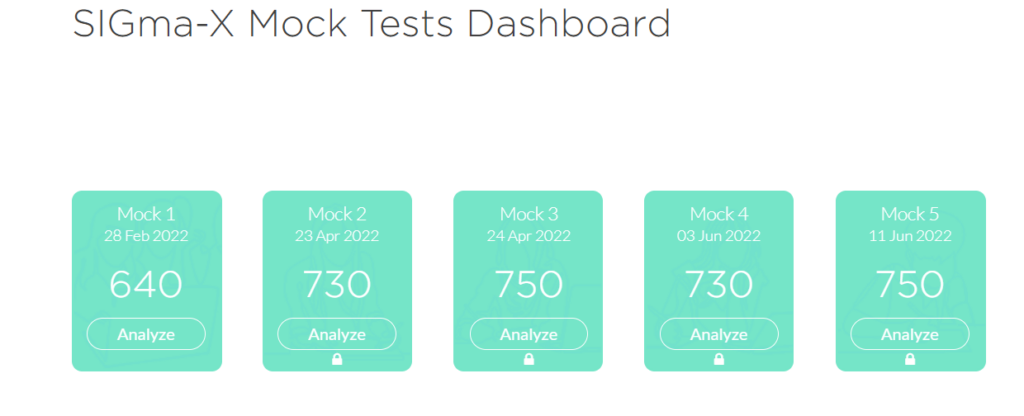
Javiera: After the SIGma-X mock 750 on 24th April, I took another OG mock and scored 760-770 before my first GMAT attempt. I scored a 710 in that, but I realized that my lower score was primarily because of the nervousness and stress that I did not perform well during the exam.
My quant performance in that attempt was relatively bad, but in verbal, I did significantly worse than any of the earlier mocks.
I decided to retake my GMAT because I knew if I did a focused study, I’d be able to score much better. The second time, only a month later, I was much calmer because I knew what I would face.
GMAT prep the in last 1 month
Payal: What kind of quizzes did you do between these two attempts?
Javiera: I had already done the concept files and only needed to practice. I’d pick 15 medium and hard-level questions, each of quant and verbal, all topics combined from the unanswered questions. Sometimes I’d only select hard questions to ensure that I was pushing myself to the point I was answering only hard questions. With this practice as I identified my faltering points and refreshed concepts by watching videos and doing focused practice on them. These combined quizzes also helped me build my stamina for the GMAT test.
Payal: You prepared in a very structured manner. The course gives you a structured process, but you followed along and did the hard work.
The thought process that went into ensuring that if you’re failing in cementing, how is it that you should be bridging those gaps or reviewing the analytics and making sure that you are bridging those gaps was completely you. We provided the course, but you used it correctly.
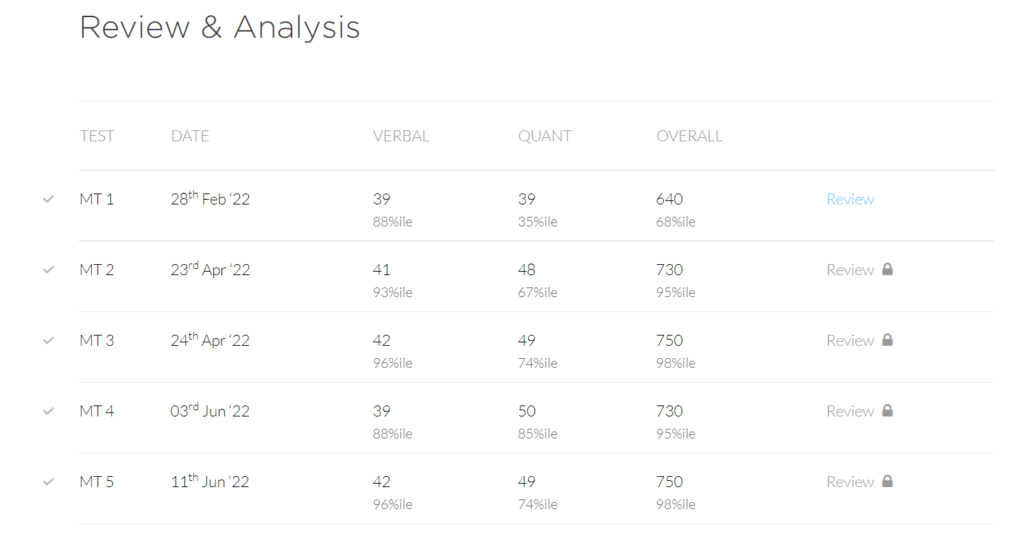
The same course is used by successful people like you and those who cannot get there. It’s you who makes the difference. So wonderful. Congratulations on that.
And now you are targeting those M-seven schools, and I do not doubt you will do well.
Three tips for GMAT aspirants
Payal: If you were to suggest three things that potential GMAT aspirants should incorporate in their study, what would those be?
Javiera: First of all, I think the most important is consistency. I never skipped a day. I would log in every day, even on the weekends or when I was tired. I think consistency is critical because you’re learning, and you need to do that learning progression every day.
The second is to trust yourself. You have to trust that you will get there. In the beginning, it seems like so far away and so hard.
And then you start looking at the things you get wrong, and you realize you can solve it. as it’s just the tiny details.
Also, try to avoid taking pressure. Even if it’s hard, try to live the process without pressure. If you don’t feel ready to take the GMAT, that’s perfectly fine.
If you thought it would take two months and then it takes three, or if you need more time to study. I think it’s okay. Just live the process as pressure-less as you can, understanding that it’s a very stressful process.
Payal: Thank you so much for this. I’m sure that GMAT aspirants who watch this video will learn a lot. It’s a very motivating story. So absolutely wonderful. Thank you so much.


